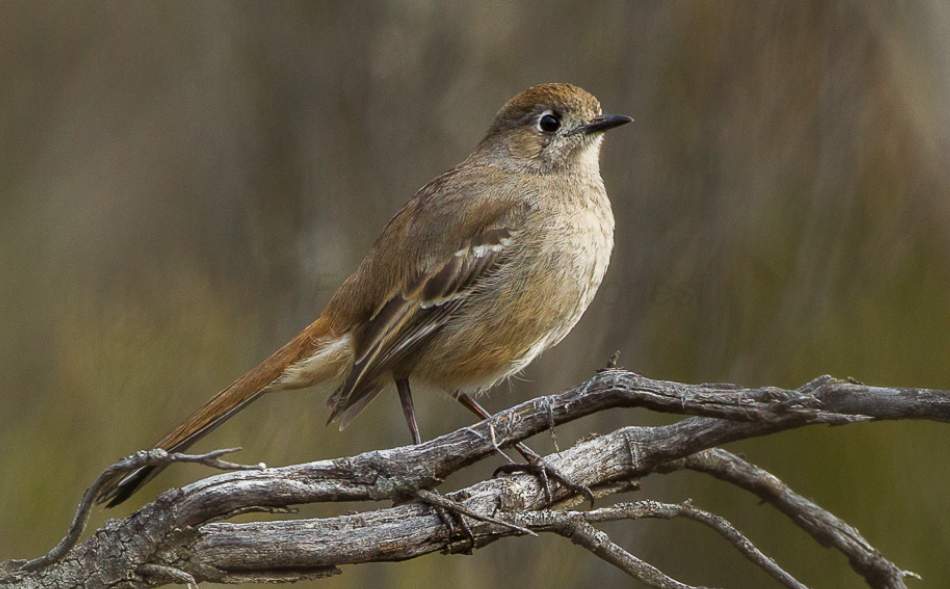Habitat: A ground bird of heathier Mallee, the Southern Scrub-robin (Drymodes brunneopygia) is thrush-like in form and behavior. In fact, some recent classifications have compared it to old-world thrushes, Turdinae. A scrub-robin, under optimal conditions, lives in a sedentary pair or a loose collective group of three or four individuals occupying one hectare or so of mallee. Their numbers have been decimated by habitat clearing for wheat, and many areas are now devoid of this once-common bird.
While foraging, it hops bouncily on the ground beneath shrubberies, cock-tails along and runs in short dashes with tail lowered, stopping to pick up food and pausing to watch, its tail rising and falling and wings flicking sporadically.
Male breeding birds also hop up into trees to send out their far-reaching territorial whistles, raising their tails again as they do so. A recent biochemical study suggests that scrub-robins are closely related to endemic Australian robins, which also exhibit similar mannerisms.
Males sing much when breeding and intermittently throughout the day, even in the middle of the day. Although females may nest-build and incubate unaided-laying only one egg, an unusual phenomenon for Australian songbirds in temperate latitudes-both sexes are responsible for feeding the young.

Similar species: Chestnut Quail-thrush, the only other species it might be confused with, is larger, has different postures (mainly due to shorter legs), and has very different plumage and head patterns.
Diet: When the birds forage alone, they use peevish, long-drawn whistles to keep in contact with each other. A major part of their diet consists of beetles and other invertebrates that live on the ground and in litter.
Identification: Both sexes are similar; the female is slightly smaller. The upper parts are uniformly dark grey-brown; the rump is rufous. The tail is dark brown with a narrow white tip on the outer feathers. Wings are dusky brown with two faint white bars on shoulders; some white edging on primaries. The face is grey with white toning on lores and eye-ring and a dusky vertical smudge through the eye. The throat and breast are pale grey, grading to white on the belly and cinnamon on the flanks and undertail. Their eyes are dark brown. Their bill and feet are dusky black. The juvenile upperparts and wings are sandy-brown with black flecks and white streaks. The underparts are white with dark feather tips on the throat and breast; the tail has a buff tip.

Call: The southern scrub-robin’s call is a long, thin, high-pitched whistle that is raised slightly as it is spoken by both sexes; also a harsh, rattling scold.
Song: The song is characterized by repeated, loud whistled notes: chip-pip-er-eee, chip-pip-ee, chip-per-a-peet, the last order rising in a male voice, usually from a vantage point.
Nest & Breed: Nesting and breeding occur from July to January. A shallow cup made from twigs and bark strips lined with fine rootlets and grass stems, usually near or beneath a bush’s trunk or within a mallee’s buttress.
Egg: Southern Scrub-robins lay a single egg, which is cream or pale green, spoiled, and blotted with brown to form a cap at one end; oval, about 25 x 19 mm.
Distribution: The mallee lands extend north to Shark Bay and east to Lake Dundas and Israelite Bay in Western Australia; south to the Eyre Peninsula in South Australia, and east to New South Wales and Victoria, with pockets in the Great Australian Bight and the Flinders Ranges in South Australia.
Family: The southern scrub robin is a species of bird in the family Petroicidae in the order Passeriformes.
Races: There are no races.
Alternative Names: It is also known as Mallee Scrub Robin and Pale Scrub Robin.
Size: The Southern Scrub-robin size is about 210-230 mm, including 100 mm tail.
Related Reading: Northern Scrub-robin (Drymodes superciliaris)







